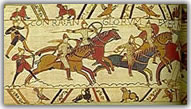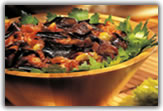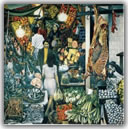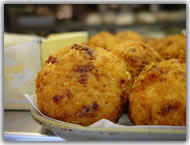| |
|
|
|
|
SicilyWine.
Stories and Legends from the Kitchen to the Cellar - 3 © |
|
|
|
|
|
JEWISH VEGETABLES: PERSIAN EGGPLANT OR "PARMIGIANA"
 The Jews of Sicily, prevalently Sephardic, were present in numerous communities and cities on the island, and their “Kasher” or “coscer” cuisine left a profound imprint on Sicilian cuisine that endures today. The Jews of Sicily, prevalently Sephardic, were present in numerous communities and cities on the island, and their “Kasher” or “coscer” cuisine left a profound imprint on Sicilian cuisine that endures today.
Vegetables and grains are the base of Sicilian Jewish cooking, and they also emphasized the use of olive oil for sautees and frying, as well as garlic for adding richness of flavor to foods such as beans, cabbage and cauliflower. With these techniques, Sicilian Jewish cooking became a prime example of the simple, yet tasty, dishes that Sicilian cuisine is famous for.
The spleen, lungs, and innards were compensation received by the Jews who worked in the slaughterhouses, and they cooked them with what was known as “sain” (in Spanish), or, in Sicilian, “saime”: a thick, creamy fat that the Arabs obtained from animals. Inserted between bread, it became a delicacy of Palermo referred to as, “pane con la milza”.
Introduced by the Arabs, and perfected by the Jews, eggplant became a universal staple of the Sicilian diet. Eggplant continues to be one of the most versatile and enjoyed vegetables in Sicilian cooking, whether fried and eaten alone, or sauteed with tomato to create pasta alla Norma, (named after the Sicilian composer Vincenzo Bellini, from Catania, whose works include the opera, "Norma"). Whether for economic or religious reasons, thick slices of fried eggplant were also popular substitutes for meat cutlets. When layered in a pan in the parmiciana way, the Sicilian dialect for “persiana”, with tomato sauce and fresh basil, it became the most famous eggplant dish in the world, even to this day: Eggplant Parmigiana |
|
|
|
|
|
THE NORMANS: FEDERICO II, WHITE WINES AND AGRODOLCE
The Normans, or men from the north, arrived in Sicily at about the year 1060. They came armed for battle, and determined to conquer a new kingdom. Rough and uncultured, the Normans found themselves facing a much more evolved and culturally diverse population.
 Federico II, also known as “Stupor Mundi”, (“Wonder of the World”) of the Hohenstaufen family, and a direct descendant of Federico Barbarossa (Redbeard), settled in Palermo, effectively making that city the capital of the Kingdom of the Two Sicilies. A man of science, and a lover of poetry (he founded the Sicilian School of Poetry 1230-1260 as one of his first attempts at unifying the “vulgar Italian” languages), Federico II was tolerant, and open to diverse cultural and religious experiences. Indeed, it was he, who, for the first time during the Middle Ages, founded a strongly centralized, secular state. The culturally eclectic sovereign loved to surround himself with both Western and Arabic academics, poets, and Jewish counselors, and, most of all, beautiful women, in keeping with Sheikh and Emirate tradition that ruled over various cities within the Sicilian kingdoms. Federico II, also known as “Stupor Mundi”, (“Wonder of the World”) of the Hohenstaufen family, and a direct descendant of Federico Barbarossa (Redbeard), settled in Palermo, effectively making that city the capital of the Kingdom of the Two Sicilies. A man of science, and a lover of poetry (he founded the Sicilian School of Poetry 1230-1260 as one of his first attempts at unifying the “vulgar Italian” languages), Federico II was tolerant, and open to diverse cultural and religious experiences. Indeed, it was he, who, for the first time during the Middle Ages, founded a strongly centralized, secular state. The culturally eclectic sovereign loved to surround himself with both Western and Arabic academics, poets, and Jewish counselors, and, most of all, beautiful women, in keeping with Sheikh and Emirate tradition that ruled over various cities within the Sicilian kingdoms.
It was a period of great prosperity and peace for Sicily and its inhabitants.
It is said that Federico’s culinary curiosity and experimentation led to the discovery of agro-dolce, or, sweet and sour, as it is called in English. The agro-dolce usually consists of a sauce made with vinegar, sugar and onions, which is often used as a condiment to fried fish, and for which Federico II was a glutton.
This same sauce, with the addition of fried eggplant, capers and olives (the tomato arrived from America during the XVI century) was used to compliment capon and other poultry. The poor, however, who could rarely afford meat, were left only with the vegetable portion, and so caponata was born.
Ann Stutch, musician, world traveler, and lover of Sicily, offers some insight into the early days of caponata:
 "Eggplant was first cultivated in India as long as 4,000 years ago, but was unknown in other parts of the world. The Arabs knew eggplant, and when they conquered Sicily in 831 A.D., they introduced it to the island, where it flourished and finally became indigenous. Caponata originated as seagoing fare. It was known as the mariner's breakfast, since it keeps well because the vinegar acts as a preservative. It then became known as "inn food". The word, caponata, derives from the Latin word caupo, which means tavern or inn. The sweet and sour taste of the dish comes directly from the Arabs, as does the use of raisins. When the Arabs conquered Sicily, they saw an island covered with vineyards that had produced wine for millennia. They were Muslim and could not drink alcohol. So they picked the grapes, dried them in the sun and used them for cooking. Thus we have raisins." "Eggplant was first cultivated in India as long as 4,000 years ago, but was unknown in other parts of the world. The Arabs knew eggplant, and when they conquered Sicily in 831 A.D., they introduced it to the island, where it flourished and finally became indigenous. Caponata originated as seagoing fare. It was known as the mariner's breakfast, since it keeps well because the vinegar acts as a preservative. It then became known as "inn food". The word, caponata, derives from the Latin word caupo, which means tavern or inn. The sweet and sour taste of the dish comes directly from the Arabs, as does the use of raisins. When the Arabs conquered Sicily, they saw an island covered with vineyards that had produced wine for millennia. They were Muslim and could not drink alcohol. So they picked the grapes, dried them in the sun and used them for cooking. Thus we have raisins."
It was around this time when Sicilians began producing large quantities of white wine, particularly in the region between Palermo and Trapani. White wine was drunk cool and in its pure form. An optimal refreshment during the summer heat, white wine became the preferred beverage for travelers on horseback, who journeyed long distances at a time and rested overnight at caravansaries, or Arab-style inns that could accommodate caravans in their large courtyards. |
|
|
|
|
|
THE SECOND MILLENIUM AND THE ADVENT OF THE WOODEN BARRELS
Around the year 1200, the Sicilians began preserving white wine in wooden barrels, allowing for better and longer conservation. Up until then, the most widely used form of preservation was the goatskin container (ancient Greece), or the terracotta jar. Sicilian earth is very rich in clay, and has, therefore, always used pottery, lacquered with a pine resin, to conserve many kinds of products. Even today, resined wine or retsina is produced in Greece. |
|
|
|
|
|
THE FRENCH, THE ARAGONESE, AND THE INTERNATIONALIZATION OF SICILIAN WINE
Carlo d’Angiò and his Frenchmen arrived in Sicily, and conquered it, at or about the year 1266, chasing away the Hohenstaufen after a series of horrendous massacres. Aside from a few linguistic terms adopted by the Sicilians, the French did not leave too deep of an imprint on the already-rich Sicilian gastronomy. One interesting example of how French language was  assimilated with Sicilian is the French term for “meat market”: boucherie. assimilated with Sicilian is the French term for “meat market”: boucherie.
Over time, the word became vucciria, and was used in reference to outdoor markets. The famous “La Vucciria” in the center of Palermo is still an authentic market operating today, and has become a tourist attraction, as well as memorialized by Sicilian modern artist, Renato Guttuso.
The first European revolution exploded in Palermo in 1282, in the form of a popular uprising against the French usurpers. Ninety years later, in 1372, the House of Aragon established itself as the definitive ruler of the entire Kingdom of the Two Sicilies, which at that time included all of the regions from Abruzzo and Molise down, comprising what is referred to as “Southern Italy” today. The capital of the Kingdom was settled at Napoli, indicating a historical detachment from Sicily.
The Spanish-Aragonese dominion represents an important period for regional enogastronomy, considering vastness of the territory, and Sicilian wine thereby began to enjoy international fame on a new level. |
|
|
|
|
|
DE NATURALI VINORUM, HISTORY AND TAVERNIERI
In 1500, an abstract on wines attributed to a certain Andrea Bacci, De Naturali Vinorum Historia, was written. Largely dedicated to Sicilian wines, the writing refers to I rossi dell’Etna (The Reds of Etna) and the wines of Val di Noto as being of high quality. On the wines of the Palermo, Cammarata and Agrigento regions, he wrote:
“...in Cammarata the vines grow prolifically, and as tall as men, so rich in grapes that ten plants are enough to render a bottle of must... The red wine is very strong, rich in fragrance and flavor, it is optimal for long-term preservation...The great wines of “Mongibello” (Etna) are good due to the natural warmth that springs from below ground... (while) the wines of Palermo are clear and light...”
Even Pope Paul IV, during the XI century loved Sicilian wines, and was known to recommend Bianco d’Alcamo most of all.
Sicilian wines became so famous that they made for extremely profitable commerce for the Venetians, Genovese, Pisans, Florentines, and Jews. It was the beginning of a cultural period that lasted until “modern” times. The “cultural backlog” in Sicily, particularly among the agricultural sector, had kept the society attached to a somewhat feudal system, whereas the rest of Italy, and most of Europe, had developed into Republics and municipalities. As a consequence, Sicilian wine was commercialized by and for foreigners, used mostly as an additive for French, Spanish, and Northern Italian wines, leaving a legacy of wine culture limited merely to a handful of passionate barons, counts, and local croppers.
The business of wine did not adhere to many standards of quality at that time. Negligence, ignorance, and apathy accompanied Sicilian wine toward oblivion and mediocrity, with respect to other aspects of culture that were considered more important. In fact, the business of Sicilian wine and produce in the North was managed almost entirely by those from Lombardy, a traffic pattern which led to the formation of La Maestranza dei Tavernieri or “The Majesty of the Public House Keepers”, in 1545. |
|
|
|
|
|
THE LEGEND OF SAINT LUCY, "ARANCINI" AND "PANELLE"
Saint Lucy of Syracuse (283-304) is the saint of Light and a protector of the Christian Faith, and, in terms of popular tradition, probably the most venerated Sicilian saint in the world.
 On December 13th of each year, presumably since the XV Century, Sicilians pay tribute to her at the dinner table. On this day it is customary to renounce pasta, the traditional Italian meal, as well as all other foods containing wheat flour, in her honor. In Sicily, the majority of food stores are closed on St. Lucy’s Day. So what do they eat? If you are in Palermo, the answer to this question is obvious: panelle and arancine. Arancine di riso, fried balls of rice (a grain introduced by the Arabs) typically made with fillings such as tomato sauce with meat (ragù), butter with peas and prosciutto, and, more recently, dark chocolate. On December 13th of each year, presumably since the XV Century, Sicilians pay tribute to her at the dinner table. On this day it is customary to renounce pasta, the traditional Italian meal, as well as all other foods containing wheat flour, in her honor. In Sicily, the majority of food stores are closed on St. Lucy’s Day. So what do they eat? If you are in Palermo, the answer to this question is obvious: panelle and arancine. Arancine di riso, fried balls of rice (a grain introduced by the Arabs) typically made with fillings such as tomato sauce with meat (ragù), butter with peas and prosciutto, and, more recently, dark chocolate.
Panelle, on the other hand, are thin cutlets made of chickpea flour and fried in seed oil. Once referred to as “piscipanelle”, panelle were traditionally sold by street vendors as a pedestrian snack food. Today, however, panelle have become a popular food in the home, and a “must” among typical Sicilian antipasto selections in restaurants, as well.
Thus, arancine and panelle became the unofficial foods eaten in celebration of the feast day of Saint Lucy. |
|
|
|
|
|
|
|
|
|
|
|
|
|
|
|
| |
|
| |
1.
2.
3.
4.
5.
6.
7.
8.
9.
10.
11.
12.
13.
14.
15.
16.
17.
18.
19.
20.
21.
22. |
Preface
From the ancient Greeks to... Sicilywine.com
Wine for the spirit...olive oil for the body: the Greek Myths
The arrival of the vines and the legend of Dionysus
Ulysses and Polyphemus...a legendary drink
The oldest wine of the Mediterranean Sea: the Myth of Moscato di Siracusa
Populatum, Mamertinum, Tauromenitanum: the first DOC
How the ancient Romans and Byzantines drank wine
A.D. 500: Malvasia, the oldest dessert wine in the world, arrives
The Arabs. Zibibbo, spaghetti and cassata
Jewish Vegetables: Persian Eggplant or “Parmigiana”
The Normans: Federico II, White Wines and Agrodolce
The Second Millenium and the Advent of the Wooden Barrels
The French, the Aragonese, and the Internationalization of Sicilian Wines
De Naturali Vinorum, History and the Tavernieri
The Legend of Saint Lucy, "Arancini" and "Panelle"
The Beautifully sweet illusion of the “Martorana fruit” or “Marzipan”, and Procopio
From the Spanish to the Florios
Woodhouse. Nelson. Whitaker. The English tradition in "Sicilywine"
From Spaghetti alla Norma to Marsala "Dolce Garibaldi"
The Florio Family
SICILYWINE.COM: Where tradition meets the future...
|
|
|
|
|
|
|
|
|